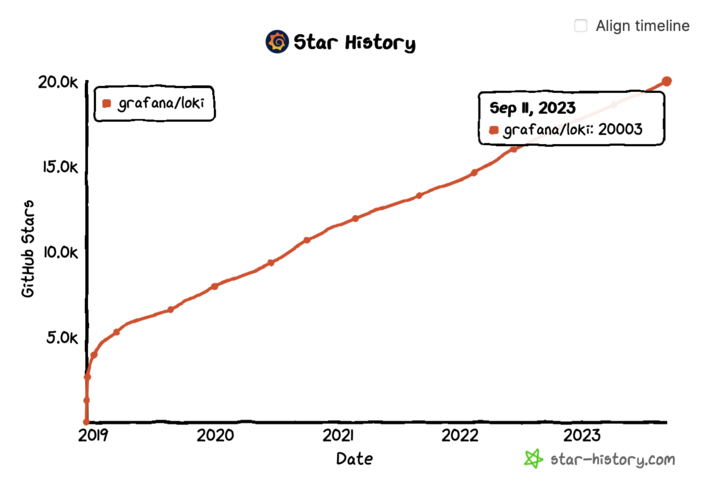
Grafana Loki hits 20K GitHub stars: 20 fun facts about the open source logging project
The Grafana Loki GitHub repository just hit 20K stars! You can’t exchange GitHub stars for coffee at Starbucks or pay rent with it, but this is a big milestone that is a testament to the enormous momentum of this open source project. Thank you to the Grafana Loki community — this couldn’t have been possible without you!

To celebrate this 20K benchmark, here are 20 completely random, but fun facts and tips about Grafana Loki:
Grafana Loki was first introduced at KubeCon Seattle in December 2018 by our (now) CTO Tom Wilkie.
There are more than 100,000 active Grafana Loki clusters in the wild and more than 1 billion Docker Hub image pulls of the project.
The official team behind Grafana Loki OSS is currently 20 members strong.
More than 1,100 participants have attended our “Introduction to Loki” workshop since its inception in late 2020! Sign up to get notified about the next workshop and join us either in person or online.
The Loki project has published 40 releases since the first beta release on June 3, 2019. Loki was officially generally available in November 2019.
To date, the main branch of the Loki GitHub project has received 5,586 commits by more than 100 contributors!
The first commit on the Loki GitHub repo was made by Tom Wilkie on April 15, 2018.
Writing LogQL, the powerful log query language inspired by PromQL, became much easier with the introduction of the Grafana Loki query builder in Grafana 9.
Check out the blazing fast pattern parser for unstructured log formats introduced in Loki 2.3.
Big milestone releases such as Loki 2.4, which removed the ordering constraint, have made it even easier to use Loki.
RedHat has adopted Loki for log aggregation next to Grafana and Prometheus for their OpenShift Kubernetes distribution.
The new Loki TSDB-based index introduced in the 2.7 release is a game changer. With this more efficient, faster, and scalable TSDB index, Loki has seen peaks of 1TB/sec of search throughput. It also resides in object storage like the boltdb-shipper index, which preceded it. Read all about it in Loki maintainer Owen Diehl’s blog post on the TSDB.
There’s supposed to be a video here, but for some reason there isn’t. Either we entered the id wrong (oops!), or Vimeo is down. If it’s the latter, we’d expect they’ll be back up and running soon. In the meantime, check out our blog!
Simple scalable deployment (SSD) mode makes it easier to deploy Loki in production. If your volume of logs exceeds a few hundred GB a day, or if you would like to separate read and write concerns, Loki provides the simple scalable deployment (SSD) mode. This deployment mode can scale to several TBs of logs per day and more. You can also consider the more complex microservices mode approach for very large Loki installations if you want additional fine-grained control over each component.
There are many, many great articles and presentations by the Loki community, and we don’t want to name favorites. You can check out all the Loki-related blog posts and presentations that have been posted over the years on the Grafana Labs blog.
Grafana Cloud runs very large multi-tenant clusters that are powered by Grafana Loki for customers such as Houzz, Paradigm, and Medallia. There are clusters doing close to 2PB of logs ingested per month, and we’re working actively with customers to move this needle with every release of Loki.
The Grafana logs observability team keeps introducing awesome updates to improve how you explore your logs, like the redesigned log context in Grafana 10.
The Loki Nginx dashboards, created to show off the capabilities of Loki and LogQL, are an evergreen favorite of the community.
Stay tuned for more game changing features! There is a lot of good momentum in OpenTelemetry for its new log standard. Send OpenTelemetry data to a Grafana Cloud OTLP endpoint.
More exciting announcements regarding Grafana Loki are coming at ObservabilityCON 2023, the premier event for open source observability that is coming to London on Nov. 14-15. Sign up today for all the latest updates.
And if you got this far in the list, thank you for being part of the Loki community and contributing to the amazing momentum of Grafana Loki. Let’s go for 30K GitHub stars and beyond!
Interested in learning more about logging? Check out our recent episode of Grafana Office Hours “Getting started with Grafana Loki,” which covers why you need log aggregation, how Loki works, how Loki fits into the Grafana LGTM stack, and more.
You can also dive into our Grafana Loki documentation or check out our upcoming “How to get started with logging” webinar.



